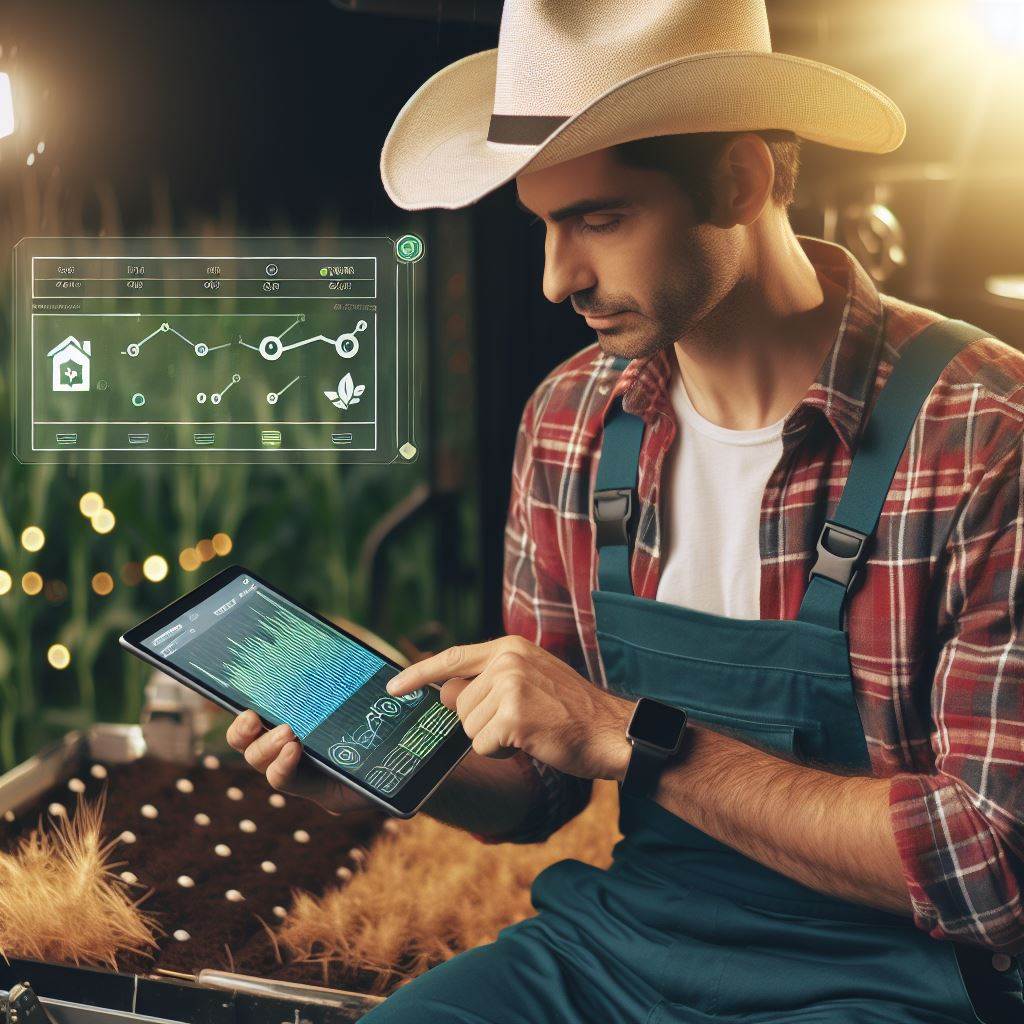Introduction
In today’s world, “Data Driven Farming Tech for Crop Analysis” has emerged as a game-changer in the agriculture industry.
It involves the use of technology to collect and analyze data from crops in order to make informed decisions.
This approach has revolutionized the way farmers grow and manage their crops.
Definition of data-driven farming
Data-driven farming refers to the practice of using data and technology to analyze various aspects of crop growth, such as soil conditions, weather patterns, and nutrient levels.
It involves collecting data from sensors, drones, satellite imagery, and other sources to make data-driven decisions.
Importance of crop analysis in modern agriculture
Crop analysis plays a vital role in modern agriculture for several reasons.
Firstly, it helps farmers optimize crop yield and reduce waste by providing valuable insights into the health and growth of crops.
By analyzing data, farmers can identify potential issues and take preventive measures to protect their crops.
Secondly, crop analysis enables farmers to make precise and informed decisions regarding planting, fertilization, irrigation, and harvesting.
By analyzing data, farmers can determine the exact amount of water, fertilizer, and other inputs required for optimal crop growth.
This not only improves crop quality but also minimizes costs and environmental impact.
Furthermore, crop analysis helps farmers detect diseases, pests, and weed infestations early on.
By monitoring data, farmers can identify patterns and anomalies that indicate potential risks to their crops.
This allows them to implement targeted interventions, such as applying pesticides or adjusting irrigation, to prevent or minimize crop damage.
In fact, data-driven farming and crop analysis have revolutionized modern agriculture.
By leveraging technology and analyzing data, farmers can make informed decisions, optimize crop yield, reduce waste, and protect their crops from various risks.
This approach has the potential to significantly improve the efficiency and sustainability of farming practices.
The Role of Technology in Data-Driven Farming
Data-driven farming, also known as precision agriculture, utilizes various technological advancements to improve crop analysis and enhance farming practices.
These technologies enable farmers to collect and analyze vast amounts of data, providing crucial insights for smarter decision-making.
Overview of Technological Advancements in Agriculture
Technology has revolutionized the agricultural industry, making it more efficient, sustainable, and profitable than ever before.
Farmers can now rely on a wide range of tools and techniques to optimize their farming processes and maximize yields.
Let’s explore some examples of technology used for crop analysis.
Examples of Technology used for Crop Analysis
1. Remote Sensing
Remote sensing involves using satellites or aircraft to gather data about crop health, growth patterns, and nutrient levels.
This technology captures images in different wavelengths, providing farmers with valuable information about field conditions and potential issues.
2. Drones
Drones have become increasingly popular in agriculture due to their ability to collect high-resolution aerial imagery.
Farmers can use drones to assess crop health, identify areas of stress, and monitor irrigation systems.
This data aids in early detection of diseases or nutrient deficiencies, enabling timely interventions to prevent yield loss.
3. Automated Weather Stations
Automated weather stations are equipped with sensors that measure various environmental factors such as temperature, humidity, rainfall, and wind speed.
By collecting real-time weather data, farmers can make informed decisions regarding irrigation, pest control, and crop protection measures.
4. Soil Sensors
Soil sensors provide continuous monitoring of soil moisture, temperature, and nutrient levels.
Farmers can place these sensors at different depths in their fields to gather accurate data about soil conditions.
This information helps them optimize irrigation schedules, manage fertilizer applications, and prevent water wastage or nutrient runoff.
In short, the integration of technology in data-driven farming has revolutionized the agricultural landscape.
These modern tools and techniques enable farmers to collect valuable data about their crops and make informed decisions to optimize productivity while minimizing environmental impact.
By harnessing the power of remote sensing, drones, automated weather stations, and soil sensors, farmers can maximize yields, reduce costs, and contribute to sustainable farming practices.
Benefits of Data-Driven Farming
Increased Crop Yield and Quality
- Data-driven farming enables farmers to analyze crop data and make informed decisions.
- By using data-driven techniques, farmers can optimize irrigation, fertilization, and pest control, improving crop yield.
- Monitoring crop health through data analysis helps identify potential diseases or infestations, ensuring better crop quality.
- Precise data-driven planning leads to improved seed selection, resulting in higher-yielding and more resistant crops.
Reduced Resource Wastage
- Data-driven farming allows farmers to optimize resource allocation, reducing wastage of water, fertilizers, and pesticides.
- By using sensor technology and real-time data analysis, farmers can optimize irrigation and reduce water consumption.
- Accurate analysis of soil conditions helps minimize fertilizer usage and prevents over-application, reducing environmental impact.
- Data-driven pest management enables targeted spraying, minimizing chemical use and preserving beneficial insects and organisms.
Improved Decision-Making
- Data-driven farming provides farmers with real-time insights, enabling timely and informed decision-making.
- By analyzing historical data and weather patterns, farmers can plan planting and harvesting activities more efficiently.
- Access to crop data helps farmers identify the most suitable planting and cultivation techniques for specific conditions.
- Data-driven tools offer predictive analytics that assist farmers in managing risks and adapting to changing market demands.
Enhanced Sustainability and Environmental Stewardship
- Data-driven farming promotes sustainable practices by reducing the environmental impact of agricultural activities.
- By optimizing resource usage, farmers contribute to the conservation of water and minimize pollution.
- Precision agriculture techniques help preserve biodiversity by minimizing the use of harmful chemicals.
- Data-driven farming practices support long-term sustainability, ensuring the land’s productivity for future generations.
In general, data-driven farming brings numerous benefits to farmers and the environment.
By harnessing the power of technology and data analysis, farmers can increase crop yield and quality while reducing resource wastage.
The ability to make informed decisions based on real-time insights improves efficiency and productivity.
Moreover, data-driven farming practices contribute to environmental sustainability by minimizing the use of harmful chemicals and optimizing resource allocation.
Embracing data-driven techniques is crucial for ensuring a prosperous, sustainable, and environmentally conscious future for agriculture.
Read: Understanding Soil Texture and Crops
Crop Analysis Techniques
Importance of soil composition analysis
- Optimizing crop yield: By knowing the soil composition, farmers can adjust their cultivation practices to ensure maximum productivity.
- Detecting nutrient deficiencies: Soil analysis helps identify nutrient deficiencies, allowing farmers to make informed decisions regarding fertilization.
- Precision agriculture: Understanding soil composition enables farmers to implement precision farming techniques and reduce resource wastage.
- Preventing environmental contamination: By analyzing soil composition, farmers can identify potential contaminants and take steps to mitigate them.
Techniques for collecting soil samples
- Grid sampling: In this method, a grid is superimposed over the field, and samples are collected at the intersection points.
- Zigzag sampling: This technique involves collecting soil samples by walking in a zigzag pattern across the field.
- Zonal sampling: With zonal sampling, the field is divided into zones based on factors like soil texture or elevation, and samples are collected from each zone.
Lab analysis and interpretation of results
- Physical analysis: Tests are conducted to determine soil texture, moisture content, and other physical properties.
- Chemical analysis: Various tests are performed to measure the soil’s pH, nutrient content, organic matter, and presence of contaminants.
- Interpretation of results: The laboratory provides farmers with a detailed report that interprets the analyzed data, highlighting areas of concern or improvement.
- Recommendations: Based on the analysis, the laboratory may provide recommendations for fertilization, soil amendments, or other necessary interventions.
In review, soil analysis plays a vital role in modern data-driven farming.
By understanding the soil composition, farmers can optimize crop yield, detect nutrient deficiencies, implement precision agriculture, and prevent environmental contamination.
Techniques such as grid sampling, zigzag sampling, and zonal sampling enable efficient collection of soil samples.
Laboratory analysis provides valuable insights into the physical and chemical properties of the soil, allowing farmers to make informed decisions and receive recommendations for improved cultivation practices.
Transform Your Agribusiness
Unlock your farm's potential with expert advice tailored to your needs. Get actionable steps that drive real results.
Get StartedRead: Soil Aeration Techniques for Farmers

Crop Health Monitoring
Remote Sensing for Plant Health Assessment
- Remote sensing technology provides a valuable tool for assessing the health of crops.
- By capturing data from satellites or aerial platforms, it enables farmers to monitor large areas.
- Remote sensing allows for the detection of stress factors like nutritional deficiencies or water scarcity.
- This technology utilizes various sensors to analyze vegetation indices, such as NDVI, to assess crop health.
- The data obtained can indicate the presence of pests or diseases even before visible symptoms appear.
Drone-Based Imaging for Early Pest Detection
- Drones equipped with imaging sensors offer a game-changing solution for early pest detection.
- The high-resolution imagery captured by drones enables farmers to identify pest infestations at an early stage.
- By spotting pests early, farmers can take immediate action to prevent extensive damage to their crops.
- Drones provide a cost-effective and efficient method for regularly monitoring large areas of farmland.
- When combined with machine learning algorithms, drone imagery can automatically identify specific pest species.
Disease Identification through Computer Vision
- Computer vision, a branch of artificial intelligence, has revolutionized disease identification in crops.
- Advanced algorithms enable computers to analyze images and detect diseases with high accuracy.
- By examining leaf discoloration or deformation, computer vision algorithms identify disease symptoms.
- This technology can differentiate between various diseases, assisting in targeted treatment approaches.
- Disease identification through computer vision saves farmers time, allowing for early intervention and reducing yield losses.
In summary, data-driven farming has introduced innovative technologies for crop health monitoring.
Remote sensing using satellites or aerial platforms helps assess plant health, detect stress factors, and identify pests or diseases.
Drone-based imaging provides early pest detection capabilities, while computer vision offers accurate disease identification.
By implementing these technologies, farmers can proactively manage crop health and address issues promptly, leading to higher yields and sustainable farming practices.
Read: Balancing Soil Nutrients: A How-To
Data Management and Analysis
In the realm of data-driven farming, effective data management and analysis play a crucial role.
Challenges in data collection
- Data collection can be challenging due to the vast amount of information generated by modern farming technologies.
- Farmers often struggle with collecting and organizing data from various sources, such as sensors and machinery.
- Poor data collection practices can lead to inaccurate insights and hinder the potential of data-driven farming.
Importance of data management systems
- Data management systems are essential for organizing and storing data in a centralized and accessible manner.
- These systems enable farmers to keep track of vast amounts of data, ensuring its reliability and availability.
- Accessible data management systems facilitate collaborative efforts, allowing multiple stakeholders to benefit from shared insights.
- Proper data management lowers the risk of data loss or corruption, safeguarding valuable information for future analysis.
- Furthermore, secure data management systems comply with privacy regulations to protect sensitive farm data.
Utilizing artificial intelligence and machine learning for data analysis
- The rapid advancements in artificial intelligence (AI) and machine learning (ML) have revolutionized data analysis in farming.
- AI and ML algorithms help in analyzing complex farming datasets, extracting valuable patterns, and making informed decisions.
- These technologies can predict crop yields, analyze soil composition, and identify potential pests or diseases, leading to proactive interventions.
- AI-powered drones and satellite imagery aid in monitoring crop health and identifying areas that require attention.
- Real-time data analysis enables farmers to optimize resource allocation, adjust irrigation schedules, and implement precision farming techniques.
In a nutshell, effective data management and analysis are fundamental pillars of data-driven farming.
Read: Water Management in Soil Fertility
Case Studies of Successful Data-Driven Farming
Spencer Farms
Spencer Farms, located in a remote area, successfully implemented data-driven practices to optimize crop production.
By collecting and analyzing weather patterns, soil data, and historical yield data, they were able to make informed decisions about irrigation, fertilization, and planting schedules.
The use of sensors throughout the farm allowed for real-time data collection, providing valuable insights into field conditions.
This data-driven approach helped Spencer Farms detect early signs of disease and pest infestations, enabling them to take immediate action, minimizing crop losses.
By fine-tuning their irrigation system based on accurate data, Spencer Farms achieved significant water savings while maximizing crop yield.
This resulted in not only increased profitability but also reduced environmental impact.
Meadows Organic Farm
Meadows Organic Farm adopted data-driven farming practices to improve sustainability and organic certification compliance.
Through data analysis, they determined the optimal timing for planting cover crops and rotating crops to maintain soil health and reduce pest pressure.
By monitoring soil nutrient levels and using predictive analytics, Meadows Organic Farm reduced the need for synthetic fertilizers while ensuring optimal nutrient availability for their crops.
This not only saved costs but also enhanced the overall quality of their produce.
Moreover, leveraging satellite imagery and drones, Meadows Organic Farm identified areas with weed growth issues and implemented targeted weed control measures.
This reduced the reliance on herbicides and enhanced crop productivity and quality.
Positive Outcomes and Increased Profitability
The successful implementation of data-driven farming practices in these case studies led to numerous positive outcomes and increased profitability for the farms.
Comprehensive data analysis empowered the farmers to make informed decisions, resulting in optimized resource allocation and reduced waste.
This, in turn, led to increased crop yield and improved product quality.
By identifying and addressing potential issues in real-time using data-driven insights, these farms minimized the risk of crop loss due to pests, diseases, or adverse weather conditions.
This translated into higher profitability and more stable income streams.
Furthermore, the use of data-driven practices allowed the farms to reduce input costs by optimizing the use of water, fertilizers, and pesticides.
This not only increased their financial viability but also contributed to sustainable farming practices.
Overall, the case studies prove that data-driven farming can significantly impact the success and profitability of agricultural operations.
With the right technology and analytical capabilities, farmers can unlock the potential of their data, leading to better decision-making, increased productivity, and enhanced sustainability.
You Might Also Like: Greenhouse Farming in a Changing Climate
Conclusion
Data-driven farming offers numerous benefits for crop analysis, revolutionizing the agricultural sector in profound ways.
Recap of the benefits of data-driven farming for crop analysis
This data helps them detect diseases, optimize irrigation, predict yields, and improve overall crop management.
The insights gained from data analysis enable farmers to make data-driven decisions and enhance their productivity.
By harnessing advanced technologies, farmers can obtain accurate and real-time data about their crops.
Encouragement for farmers to embrace technology for better agricultural practices
Farmers should proactively adopt data-driven farming practices to improve their crop yields and profitability.
By embracing technology, they can stay one step ahead of challenges and make informed choices.
Showcase Your Farming Business
Publish your professional farming services profile on our blog for a one-time fee of $200 and reach a dedicated audience of farmers and agribusiness owners.
Publish Your ProfileLearning how to interpret and apply data for crop analysis is crucial for sustainable and efficient farming.
The future of agriculture lies in the hands of farmers who are willing to embrace data-driven farming.
By using technology for crop analysis, farmers can optimize their resources, reduce costs, and increase yields.
Incorporating data-driven farming practices will not only benefit individual farmers, but also the global food supply chain.
It is time for farmers to seize the opportunities provided by data-driven farming and revolutionize the agricultural industry.




